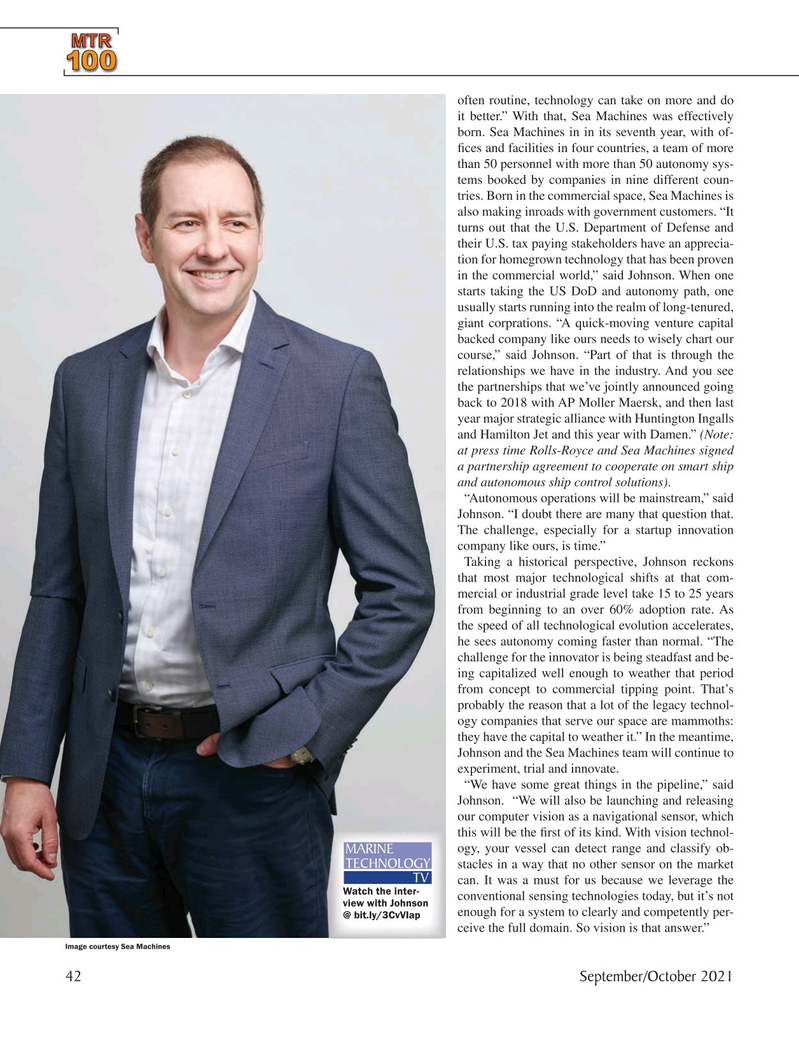
Page 42: of Marine Technology Magazine (September 2021)
MTR100: Focus on 100 Leading Companies, People and Innovations in the Subsea Space
Read this page in Pdf, Flash or Html5 edition of September 2021 Marine Technology Magazine
MTTTTTTTTTTTTTRM M M M M M M M M M M M M M M M M M M M M M M M M M M M MTRRRRRRRRRRRRRRRRRRRRRRRRRRRMTTTTTTTTTTTTTRMTR 100000000000000001111111111111111111111111111100000000000000000000000000000010000000000000000100 often routine, technology can take on more and do it better.” With that, Sea Machines was effectively born. Sea Machines in in its seventh year, with of- ? ces and facilities in four countries, a team of more than 50 personnel with more than 50 autonomy sys- tems booked by companies in nine different coun- tries. Born in the commercial space, Sea Machines is also making inroads with government customers. “It turns out that the U.S. Department of Defense and their U.S. tax paying stakeholders have an apprecia- tion for homegrown technology that has been proven in the commercial world,” said Johnson. When one starts taking the US DoD and autonomy path, one usually starts running into the realm of long-tenured, giant corprations. “A quick-moving venture capital backed company like ours needs to wisely chart our course,” said Johnson. “Part of that is through the relationships we have in the industry. And you see the partnerships that we’ve jointly announced going back to 2018 with AP Moller Maersk, and then last year major strategic alliance with Huntington Ingalls and Hamilton Jet and this year with Damen.” (Note: at press time Rolls-Royce and Sea Machines signed a partnership agreement to cooperate on smart ship and autonomous ship control solutions).
“Autonomous operations will be mainstream,” said
Johnson. “I doubt there are many that question that.
The challenge, especially for a startup innovation company like ours, is time.”
Taking a historical perspective, Johnson reckons that most major technological shifts at that com- mercial or industrial grade level take 15 to 25 years from beginning to an over 60% adoption rate. As the speed of all technological evolution accelerates, he sees autonomy coming faster than normal. “The challenge for the innovator is being steadfast and be- ing capitalized well enough to weather that period from concept to commercial tipping point. That’s probably the reason that a lot of the legacy technol- ogy companies that serve our space are mammoths: they have the capital to weather it.” In the meantime,
Johnson and the Sea Machines team will continue to experiment, trial and innovate. “We have some great things in the pipeline,” said
Johnson. “We will also be launching and releasing our computer vision as a navigational sensor, which this will be the ? rst of its kind. With vision technol- ogy, your vessel can detect range and classify ob-
MARINE
TECHNOLOGY stacles in a way that no other sensor on the market
TV can. It was a must for us because we leverage the
Watch the inter- conventional sensing technologies today, but it’s not view with Johnson enough for a system to clearly and competently per- @ bit.ly/3CvVIap ceive the full domain. So vision is that answer.”
Image courtesy Sea Machines 42 September/October 2021
MTR #7 (34-49).indd 42 9/22/2021 2:25:11 PM

 41
41

 43
43
